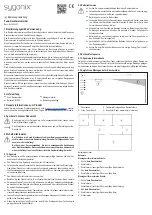
11 Nuisance alarm
Cigarette smoke or vapour from cooking can activate the wireless smoke detector. Nuisance
alarms are also possible in case of exposure to dust when grinding (e.g. when renovating a
room) and if too much hair spray/deodorant is sprayed in a room or similar.
Normally, smoking cigarettes in the room will not trigger the wireless smoke detector
unless the smoke is blown directly into the sensor.
If the wireless smoke detector signals an alarm, check whether the seat of fire does exist. If
fire or smoke is detected, alert your family, and everyone must leave the building. Call the fire
department. If there is no fire or smoke, check whether the alarm could have been triggered
due to the above-mentioned reasons.
12 Cleaning and maintenance
Apart from the occasional battery change, the product is maintenance-free.
Clean the outside of the product with a soft, clean, dry cloth.
Dust can be easily removed from the wireless smoke detector with a soft, clean, long-haired
brush or a vacuum cleaner. In especially dusty environments such as bedrooms, this should
be done at least once a year.
Do not use aggressive cleaning agents or chemical solutions since these can damage the
housing or impair functioning.
For safety reasons, the wireless smoke detector should be replaced every 8 years.
13 Range
This range only applies in ideal conditions with no obstructions (i.e. a direct field of
view between the transmitter and receiver without interference).
In practice, however, there may be walls, ceilings and other obstacles between the transmitter
and the receiver, which will reduce the range accordingly.
Different objects have a different impact on the range; therefore, no specific range can be
guaranteed. The range should be sufficient for use in a detached house.
Sometimes the range can be considerably reduced due to:
–
Walls, reinforced concrete ceilings and metal-framed drywalls
–
Coated/metallised insulated glass
–
Proximity to metal and conductive objects (e.g. radiators)
–
Proximity to human bodies
–
Other devices on the same frequency (e.g., wireless headphones, wireless speakers)
–
Proximity to electric motors/appliances, transformers, power supplies, computers
14 Disposal
14.1 Product
All electrical and electronic equipment placed on the European market must be
labelled with this symbol. This symbol indicates that this device should be disposed
of separately from unsorted municipal waste at the end of its service life.
Owners of WEEE shall dispose of it separately from unsorted municipal waste.
Spent batteries and accumulators, which are not enclosed by the WEEE, as well
as lamps that can be removed from the WEEE in a non-destructive manner, must
be removed by end users from the WEEE in a non-destructive manner before it is
handed over to a collection point.
Distributors of electrical and electronic equipment are legally obliged to provide free take-back
of waste. Conrad offers the following
free
return options (further information is available on
our website):
At our Conrad stores
At the Conrad collection points
At the collection points of public waste disposal agencies or at the collection systems set up
by manufacturers and distributors in accordance with the German Electrical and Electronic
Equipment Act.
The end user is responsible for deleting personal data from the WEEE to be disposed of.
It should be noted that different obligations about the return or recycling of WEEE may apply in
countries outside of Germany.
14.2 (Rechargeable) batteries
Remove batteries/rechargeable batteries, if any, and dispose of them separately from the
product. According to the Battery Directive, end users are legally obliged to return all spent
batteries/rechargeable batteries; they must not be disposed of in the normal household waste.
Batteries/rechargeable batteries containing hazardous substances are labelled with
this symbol to indicate that disposal in household waste is forbidden. The abbrevi
-
ations for heavy metals in batteries are: Cd = Cadmium, Hg = Mercury, Pb = Lead
(name on batteries/rechargeable batteries, e.g. below the trash icon on the left).
Used batteries/rechargeable batteries can be returned free of charge to local collection points,
our stores or battery retailers. You thus fulfil your statutory obligations and contribute to envi
-
ronmental protection.
Batteries/rechargeable batteries that are disposed of should be protected against short circuit
and their exposed terminals should be covered completely with insulating tape before disposal.
Even empty batteries/rechargeable batteries can contain residual energy that may cause them
to swell, burst, catch fire or explode in the event of a short circuit.
15 Declaration of Conformity (DOC)
Conrad Electronic SE, Klaus-Conrad-Straße 1, D-92240 Hirschau, hereby declares that this
product conforms to Directive 2014/53/EU.
Click on the following link to read the full text of the EU declaration of conformity:
www.
conrad.com/downloads
Enter the product item number in the search box. You can then download the EU declaration of
conformity in the available languages.
16 Technical data
Power supply ........................................3 V, CR123A (1400 mA)
Average current consumption ...............<20 µA
Frequency band ....................................868,267 – 868,3892 MHz
Transmission power..............................max. 10 mW
Range ...................................................>100 m (see chapter “Range”)
Alarm volume ........................................>=85 dB/3 m
Ambient conditions ...............................temperature -10 °C to 55 °C
..............................................................
Humidity 0% to 95% relative, non-condensing
Battery life .............................................approx. 5 years
Standard
...............................................EN 14604:2005 + AC:2008
Dimensions (L x W x H) ........................76 x 76 x 28.5 mm
Weight ..................................................68 g (without batteries)
1008
1008-CPR-MC 69266125 0001
22
DC 3 V
(CR123A/5 years)
Test the alarm for correct operation using
the test facility, whenever the battery is
replaced
Wireless distance
: >100 m (open field)
Wireless frequency
: 868.3 MHz
Smoke Alarm
ZR150SR
Distributed by Conrad Electronic SE,
Klaus-Conrad-Str. 1, D-92240 Hirschau
Tested according to:
EN 14604:2005
EN 14604: 2005/AC:2008
WEEE-Reg.-Nr.:
DE28001718
This is a publication by Conrad Electronic SE, Klaus-Conrad-Str. 1, D-92240 Hirschau (www.conrad.com).
All rights including translation reserved. Reproduction by any method, e.g. photocopy, microfilming, or the capture in
electronic data processing systems require the prior written approval by the editor. Reprinting, also in part, is prohibited.
This publication represent the technical status at the time of printing.
Copyright 2022 by Conrad Electronic SE.
*2520087_v4_0622_02_m_dh_en


































